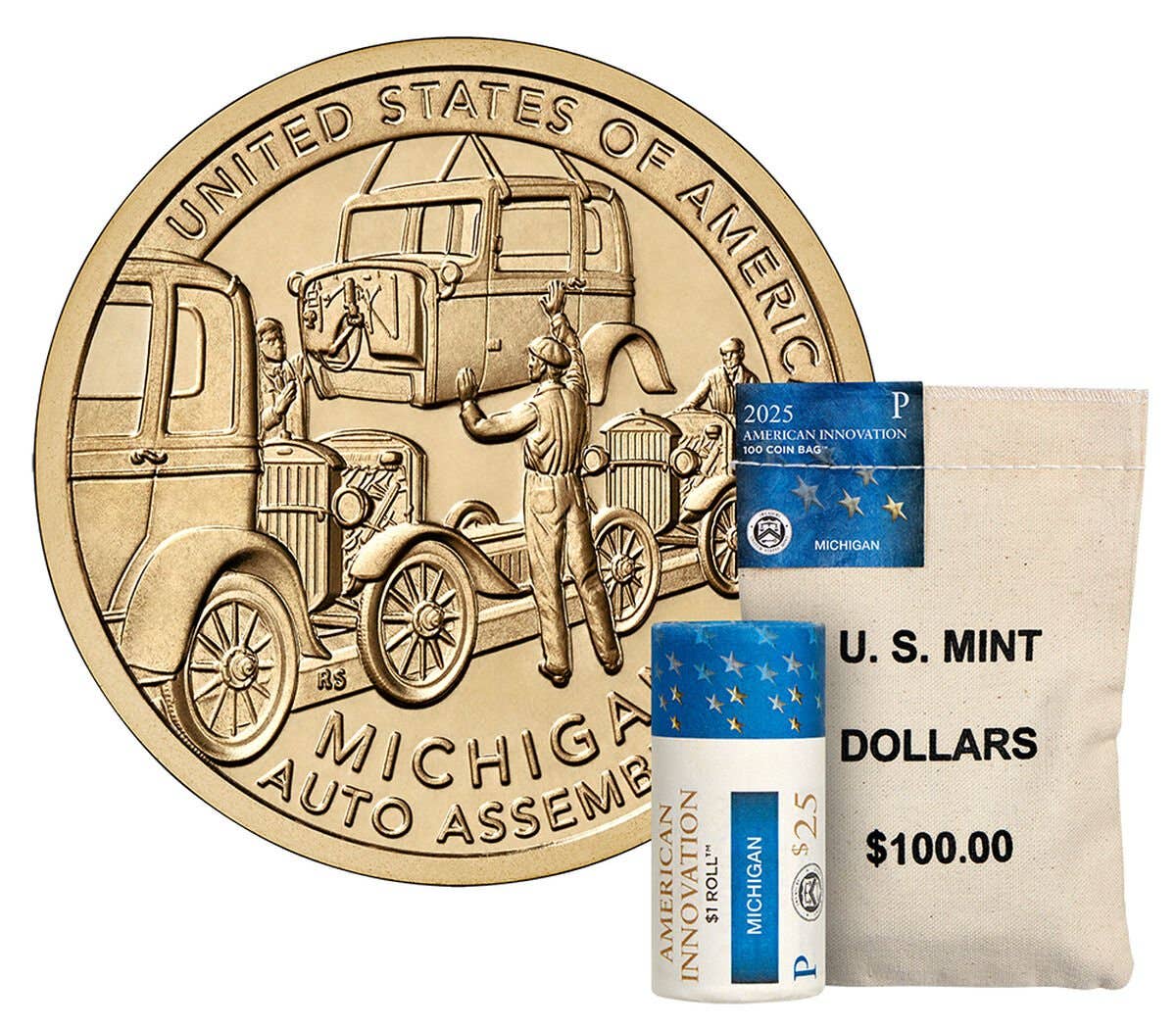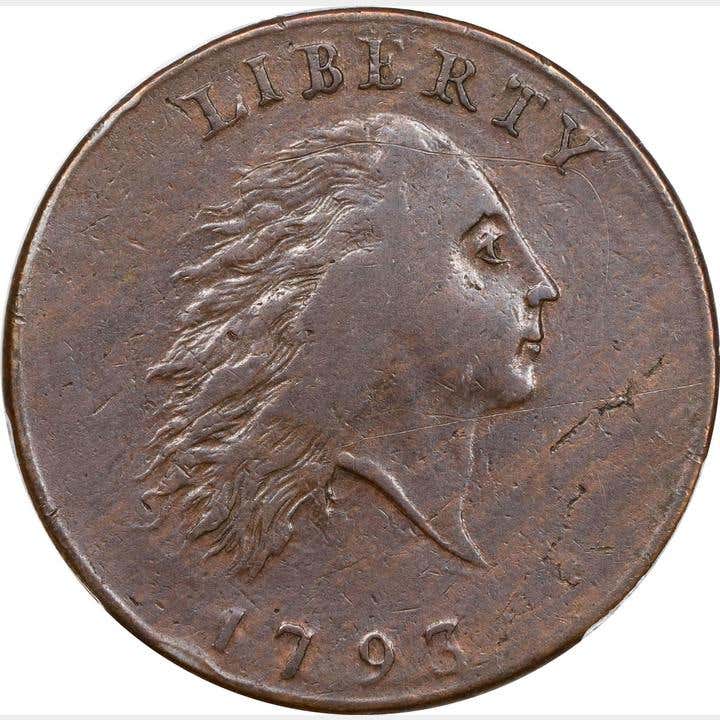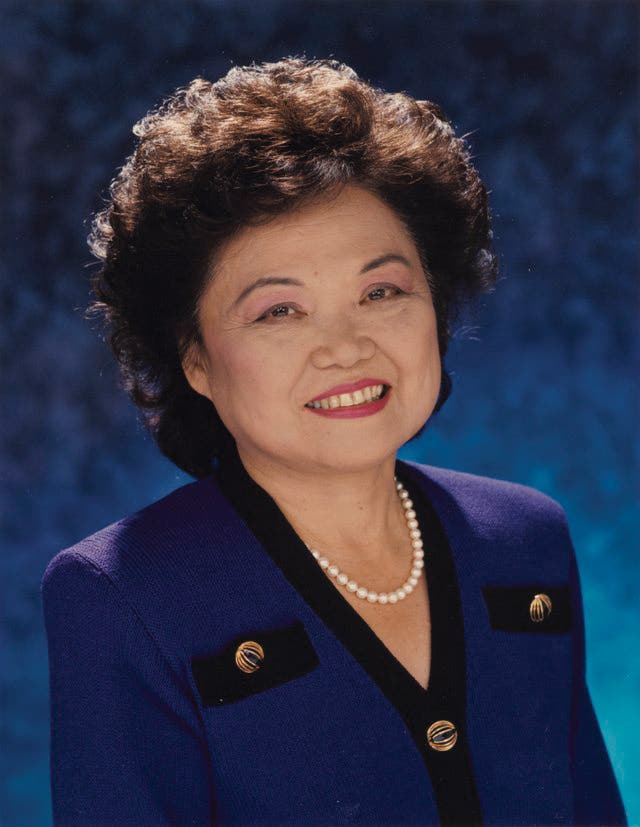Saint-Gaudens’ Model
Few would deny that Augustus Saint-Gaudens’ gold double eagle is one of the most attractive coins ever minted. Cornelius Vermeule, in his seminal Numismatic Art in America, termed it, “perhaps…
Few would deny that Augustus Saint-Gaudens’ gold double eagle is one of the most attractive coins ever minted. Cornelius Vermeule, in his seminal Numismatic Art in America, termed it, “perhaps the most majestic coin ever to bear our national imprint.”1
Few would deny that Saint-Gaudens was one of the nation’s most accomplished sculptors. John H. Dryfhout, in A Master of American Sculpture, succinctly recorded, “Augustus Saint-Gaudens has been described as an American Michelangelo, a superb craftsman, a poet and philosopher, who fitted America as Michelangelo had been suited to the Florentine and Roman scenes.”2
But equally few would find such unambiguous clarity when in comes to who modeled for his majestic gold double eagle (1907-1933) – some claim it was Mary Cunningham, whose classic features immediately enchanted him; or Davida Clark, the model for his renowned Diana; or Alice Butler, a local Vermont girl thought by some to have been his Victory.
Thanks to research by William E. Hagans, first appearing in Numismatic News, Hettie E. Anderson, an African American woman, is now most often credited. Anderson, a New York model, known to some as Saint-Gaudens’ model, posed for the Victory of New York’s Sherman Monument and was most likely the woman with “negro blood in her veins” referred to by Saint-Gaudens’ son, Homer Saint-Gaudens, in his scattershot retellings of how the Saint-Gaudens coins came to be.3
Now, more than two decades after Hagans’ award-winning article, “Author contends black lady modeled for double eagle,” was published in the Feb. 26, 1991 issue of Numismatic News, Willow Hagans and Eve M. Kahn have brought to light new biographical information on Anderson that helps paint a broader picture of her successful career.
How that came to be is the story not only of Anderson’s acclaim among sculptors and artists of her day, but also of a true American master craftsman, his rise to fame, accompanied by ever-increasing commissions, and an early 20th century desire for new coinage designs that the perpetrators of hoped would rival the breathtaking high-relief, hand-created masterpieces of ancient Greece.
Saint-Gaudens, Master Sculptor
Augustus Saint-Gaudens was born on March 1, 1848, in Dublin, Ireland, to Bernard and Mary (McGuiness) Saint-Gaudens, the family emigrating to the United States shortly after his birth, when his parents fled the Irish potato famine. Arriving in Boston in September 1848 among a veritable wave of Irish immigrants escaping the blight, the Saint-Gaudens family settled in New York, where his father opened a successful shoemaking business, catering to the day’s most influential and wealthy families. The Astors, Belmonts, Gov. Edwin D. Morgan and newspaper magnate Horace Greeley were all said to have patronized the elder Saint-Gaudens.
His son’s artistic genius was evident at an early age. As a teenager, in 1861, Augustus apprenticed with New York stone cameo cutter Louis Avet during the day. The wearing of cameos, delicately detailed from stone or shell, was popular in late 19th century America and Avet’s cameos graced the finest New York shops.
The young Saint-Gaudens showed a voracious, if-not-too-modest appetite for art, cutting cameos for Avet during the day and intensely pursuing formal drawing studies late into the night at New York’s Cooper Institute, “in the conviction that in me another heaven-born genius had been given to the world.”4
Saint-Gaudens would recall that as a lad he sometimes imagined that, “if the men standing on the platform around me [awaiting a ride] could realize how great a genius was rubbing elbows with them in the quiet-looking boy by their side, they would be profoundly impressed.”5
Leaving Avet, in 1864 Saint-Gaudens entered into the service of Jules Le Brethon, a shell cameo-cutter for whom Saint-Gaudens worked for the following three years while engaging in additional art studies at the National Academy of Design.
In 1867 Saint-Gaudens set out on the first of several extended stays in Europe. In Paris, he took a position cutting cameos for a jeweler and studied at the École gratuite de Dessin.
The following year he was admitted to the prestigious École des Beaux-Arts, joining the atelier of François Jouffroy, an artist best known for his sculpture, The Secret of Venus, the figure of a young girl whispering into Hermes’ ear.
With the outbreak of the Franco-Prussian War, Saint-Gaudens moved to Rome and took a studio with another artist and began his marble sculpture, Hiawatha, the legendary Iroquois Nation chief.
In 1872 he returned to the United States, working in a studio in New York, where one of his commissions (for the Masonic Temple in New York) was Silence, the endlessly haunting marble figure of a cloaked woman gesturing for silence.
He again went abroad the following year, where he met Augusta Homer of Roxbury (Boston), Mass., whom he would eventually marry. His stay this time was brief. Low on funds, he returned to New York in 1875 and set up a studio.
It was during this period that he received one of his first major commissions, a bronze statue of Civil War Navy Adm. David Glasgow Farragut for Madison Square Park in Manhattan. Two years later, he married Augusta, helped found the Society of American Artists, and again set off for Europe, not returning to the United States until 1880. Other commissions would follow. Notable among these was his 1891 call to prepare a monument in honor of Civil War Gen. William Tecumseh Sherman for the Grand Army Plaza in New York, work on which was begun in New York, continued upon his return to Paris in 1897 and completed in the United States.6
A perfectionist, Saint-Gaudens constantly reworked, redid and refined minute details of each new commission. The Sherman Monument was no exception. “This tendency almost endless to alter and re-alter details lasted to the close of his life ...” Homer wrote.7
Augustus was abundantly proud of the Sherman grouping. Of the figure of Victory, at its lead, he gushed in a letter to his niece, Rose Nichols, “I think I told you that my ‘Victory’ is getting on well. It’s the grandest ‘Victory’ anybody ever made.”8
Writing to his brother, Louis Saint-Gaudens, he admitted, “I’m very cocky about the ‘Sherman,’ which has turned out well, particularly the ‘Victory.’”9
To Homer, he exaggerated: “... I have got a swelled head for the first time in my life, for the ‘Sherman’ really looks bully and is smashingly fine. It’s in the place of honor at the Champ-de-Mars, and from a screeching maniac I have become a harmless, drooling, gibbering idiot, sitting all day long looking at the statue. Occasionally I fall to my knees and adore it. And there you are!”10
The Sherman Monument, situated at the entrance to New York’s Central Park at the northern end of the Grand Army Plaza, was unveiled on Memorial Day in 1903, a day filled with speeches, bands, and military and veterans parades. One of Sherman’s grandsons, William T. Sherman Thackara, performed the honors, with Saint-Gaudens and his wife, Augusta, and other dignitaries looking on from a specially built platform.11
Five years later, inspired by Saint-Gaudens’ Victory, art historian C. Lewis Hind wrote, “The feet of Victory seem hardly to touch the ground, and the inspiration of her presence, the aura of her spirit, sweeping out from her unfurled wings, sweeping forward through her outstretched arm, touch and refine the clay of horse and man to something rich and rare.”12
A Golden Family Story
It was the death of his mother in 1988, memories of an old family story, a sack of old coins, and a circa 1890s photo of a beautiful young woman that led William E. Hagans on the broken path to finding out who modeled for Victory and the Saint-Gaudens gold $20, while avoiding the many rabbit holes strewn by prior writers, including Saint-Gaudens’ son, Homer, and his niece, Rose Nichols.
“We recalled,” Hagans wrote of the photograph, “that this was the cousin my grandmother often spoke of [Harriette Eugenia Anderson, known in the family as Cousin Tootie], who had posed for an important statue in New York and was represented on a gold coin.”13
Coming across references to Saint-Gaudens’ heralded high-relief 1907 gold coins while assessing the value of the sack of old coins, Hagans decided “to investigate the time-worn family legend.”14
His research led him to John H. Dryfhout’s heavily illustrated, large-format book, The Work of Augustus Saint-Gaudens, published in 1982. In it, Dryfhout, then curator of Saint-Gaudens Historic Site in Cornish, N.H. (now the Saint-Gaudens National Historical Park), displays as his cataloging No. 164 the bust of Hettie Anderson by Saint-Gaudens, with Dryfhout’s notation that it was the first head of Victory, and the one eventually used for Saint-Gaudens’ Sherman Monument.
Inscribed on a label attached to the bust is: “FIRST SKETCH OF HEAD/ VICTORY/ SHERMAN MONUMENT” and, on the lower right side, “TO HETTIE ANDERSON/ AVGVSTVS SAINT-GAVDENS/ 1897.”15
Homer Saint-Gaudens wrote of the process taken by his father: “The initial study [of the head of Victory] failed to content him, for therein he had copied certain beautiful features until he felt that he had filled it with over much ‘personality.’ The second study, although intrinsically of more worth to him, appeared out of keeping with the monument. Therefore, he returned to his earlier attempt, and labored unfailingly over that until he developed it to his liking.”16
With Dryfhout’s book, Hagans had found a verifiable connection between Hettie Anderson and an important New York statue. Why no other sources penned since the completion of the Sherman Monument and its Victory named her as the model, he said, can be credited to the selective editing by Homer Saint-Gaudens of Augustus Saint-Gaudens’ memoirs, published following the sculptor’s death, and Hettie’s refusal to allow the Saint-Gaudens family to make a copy of the Victory bust. Homer, he wrote, worked to expunge from the record references to Davida Clark, his father’s mistress, and Hettie Anderson, his father’s African American model for the Victory on which the gold $20’s design is based. Although quite fair, Hagans wrote, Anderson was indeed black.
In August 1907, less than a week after his father’s death, Homer Saint-Gaudens wrote to Anderson, asking her to loan the bust so that a duplicate could be made.
Anderson replied in January of the following year:
“I rec’d your letter of the 9th inst asking me to loan, for the purpose of duplicating, the study of the head made from me, by Mr. Saint-Gaudens, when he first began the Sherman Group.
“When Mr. Saint Gaudens gave me the head he … said: ‘Some day this may be valuable to you, and if you will let me I will take it abroad and have it put in bronze for you, it may be worth a great deal of money.’ I thanked him … but told him that I thought I would take it then – which I did. Valueing [sic] it as I do, and knowing as I do that it is the only one in existence, in that state – I am not willing to have any duplicates made of it, for any purpose whatever.
“You will realize that if I were to allow it to be copied it would greatly depreciate its value – innumerable copies could be made of it. In my possession it is the only one and therefore more valuable.” (Dartmouth College Library.)17
Hagans said Hettie’s fear of duplication was not unfounded. A second, later head of Victory (Dryfhout No. 185), the so-called NIKH-EIPHNH Victory-Peace version, 1902-1903, was copied in quantity and sold commercially.
According to Hagans, the price Anderson paid for not giving in to Homer’s request to copy the original 1897 Victory bust was to be left out of history as having been the model for the head and torso of Victory.
In 1913 Homer Saint-Gaudens supervised the editing of his father’s memoirs, renaming it The Reminiscences of Augustus Saint-Gaudens – the unpublished version having been titled by his father, The Reminiscences of an Idiot. He left out Anderson’s Victory bust from its catalog of his father’s work. This despite the fact that by that time it had been bronzed and placed on display, in 1908, at a memorial of the sculptor’s work at New York’s Metropolitan Museum of Art.18
The Handsomest Model
That Hettie Anderson was the model for Victory is clear. That Augustus Saint-Gaudens admired her as a model is also clear. On multiple occasions, Saint-Gaudens wrote glowing of her. In a Jan. 26, 1897, letter to his niece, Rose Nichols, he informed: “I commence the nude of the Victory from a South Carolina girl with a figure like a goddess. She has just a trace of negro but would resent bitterly any allusion to that fact.”19
In the unpublished Idiot version of his life, he added: “I … modeled … the nude for the figure of Victory of the Sherman group, from certainly the handsomest model I have ever seen of either sex, and I have seen a great many ... The model was a young woman from Georgia [sic, South Carolina], dark long legged, which is not common with women, and which if not exaggerated, is an essential requirement for beauty; Besides she had what is also rare with handsome models, a power of posing patiently, steadily and thoroughly in the spirit one wished.…” (Dartmouth College Library.)20
In February 1897 Saint-Gaudens reported to Nichols that work was progressing rapidly with his Victory model. He also mentioned that Swedish artist Anders Zorn had made an etching of him and of his model during a rest period. “I had another day with the model for the Victory, last Sunday,” Saint-Gaudens wrote, “and that, too, is progressing rapidly. Zorn, the Swedish artist, was with me all day Sunday, making an etching of me while the model rested; it is an admirable thing and I will send you a copy of it.”21
This letter appears in Homer Saint-Gaudens’ version of the memoirs but with the substitution of a different Zorn etching than that mentioned by Augustus. Made in Paris the following year, the substitute etching of Augustus Saint-Gaudens depicts a portion of Saint-Gaudens’ Puritan statue in the background, not his Victory model, Hettie Anderson.
The Puritan version of the etching is also shown in Nichols’ “Familiar Letters of Augustus Saint-Gaudens,” which ran in the October and November 1908 issues of McClure’s Magazine. There, the aforementioned Jan. 26, 1897, letter from Saint-Gaudens to Nichols is reproduced but without the reference to the model for Victory’s race. Nichols tellingly ended the transcription of her uncle’s letter just after “with a figure like a goddess,” dropping the “trace of negro” reference that followed.22
Hagans wrote of Zorn’s 1897 etching of Saint-Gaudens with the model, “the etching is a beautiful representation of the obviously tired, middle-aged sculptor, his distinctive leonine features half obscured by shade, and the vibrant young model reclining nude in the background, surrounded by Zorn’s swirling lines,” adding, “It has been assumed by some that the model was Davida, his mistress, but the resemblance to Hettie Anderson is unmistakable.”23 It is also extremely unlikely that the sculptor would have switched models from time of his late January 1897 letter to Nichols and Zorn’s visit the following month.
Ten years after Zorn’s etchings were made, Augustus Saint-Gaudens wrote to the artist in August 1906: “Your masterpiece of me hangs in my study and is a constant pleasure; I wish I could really repay you for it. You know I promised you a reduction of my nude of the Goddess-like Miss Anderson, but … it was destroyed in the fire [of 1904 at Cornish, N.H.] …” (Zorn Collections, Mora, Sweden.)24
In Search of Wings and Headdress
Additional research by Hagans into the letters of sculptor Adolph Weinman led to the discovery of a highly suggestive letter written by Saint-Gaudens during the time period in which work was progressing on the high-relief double eagle design.
In a Nov. 14, 1905, letter to Saint-Gaudens, President Theodore Roosevelt, who was spearheading the drive to improve the nation’s coinage designs, had suggested the addition of a Native American headdress.25 Saint-Gaudens concurred eight days later and was soon in search of the same.
In a Jan. 2, 1906, letter to Weinman, Saint-Gaudens wrote: “Dear Weinman: Will you please mail the enclosed letter to Miss Anderson. Perhaps if she is posing for you, you might let her go for one, two or three days, I need her badly …”26
Weinman responded promptly, telling Saint-Gaudens he had forwarded the letter to Anderson.27 Hagans wrote in the Smithsonian’s American Art journal, “The destruction of the nude of Victory two years before in a fire at Cornish [N.H.] helps explain Saint-Gaudens’s urgent need of Anderson as a model for the coin. He essentially transformed his Victory into the design of Liberty for the twenty-dollar gold piece.”28
Following Roosevelt’s suggestion, on Jan. 7, 1906, Saint-Gaudens wrote to Weinman in search of a Native American headdress. He would also inquire of Weinman, this time for angel wings, “but like the headdress, found the wings difficult to integrate into the design of the twenty-dollar gold piece.”29
Gravely ill with cancer, Saint-Gaudens gave the modeling duty over to an assistant, Henry Hering. Saint-Gaudens died on Aug. 3, 1907. His coins were released into circulation shortly thereafter.
Award-Winning Writer
William E. Hagans passed away in 2015. His landmark article for the Feb. 26, 1991, issue of Numismatic News on Hettie Anderson won the Numismatic Literary Guild’s (NLG) Best Article award that year. He received at least three more NLG awards for subsequent scholarly articles in Coins magazine. His topics in that publication included detailed pieces on Saint-Gaudens, Adolph Weinman, Bela Lyon Pratt and Henry Hering.
In 1998 he recapped his findings (“Who Really Modeled for Saint-Gaudens’s $20 Gold Coin: The Case for Hettie Anderson”) for the November issue of Coins, and four years later wrote, “Saint-Gaudens, Zorn, and the Goddesslike Miss Anderson,” for the Summer 2002 issue of American Art journal.
He was also a contributor to the Encyclopedia of Sculpture and the Encyclopedia of Artists’ Models.30
In 2009 William and his wife, Willow Hagans, wrote a definitive work on Saint-Gaudens’ friend, Anders Zorn. The 390-page treatise, Zorn in America: A Swedish Impressionist of the Gilded Ages, published by the Swedish-American Historical Society, received considerable praise for chronicling the influential Swedish artist’s time in America.
Today, Willow, in collaboration with independent scholar Eve M. Kahn, continues to research the background of Hettie Anderson. Kahn’s article, “Hettie Anderson, Sculptors’ Model Who Evaded Fame,” recently appeared in the New York Times as part of its “Overlooked” series.31
Kahn has also given presentations on Anderson and penned an article for the September/October 2021 issue of The Magazine Antiques, “The Woman Who Was Victory….”
The biographical information that follows is based on Willow and Eve’s findings to date as to Anderson, her family and the major works for which she is believed to have posed.
The Goddess-Like Miss Anderson
Hettie Anderson was born in 1873 to Benjamin Dickerson and Caroline Lee Scott in Columbia, S.C. Her first name is sometimes recorded as Harriette, Harriet and she at times used Hattie.
By 1895, not long before she posed for Victory, Hettie was living in Manhattan, her last name now Anderson. Like her mother, Caroline, who did seamstress work, Hettie supported herself in that manner and at times was working as a clerk. She also trained and was modeling at the Art Students League while renting an apartment at 698 Amsterdam Ave. on New York’s upper west side.
Besides her modeling for Augustus Saint-Gaudens, she posed for an impressive array of sculptors and their prominent works. These include Adolph Weinman (Civic Fame on top of the David N. Dinkins Manhattan Municipal Building); Edwin Blashfield (murals at the Library of Congress in Washington, D.C.); John Quincy Adams Ward (winged Victory on the Dewey Arch in New York); and Daniel Chester French (Truth for the Boston Public Library doors; Angel of Peace on the grave of Rutherfurd Stuyvesant in New Jersey; the Spirit of Life in Saratoga Springs, N.Y.; Mourning Victory in Sleepy Hollow Cemetery in Concord, Mass.; and Sculpture, alongside the steps at the Saint Louis Art Museum). She also modeled for John La Farge, Anders Zorn, Bela Lyon Pratt and Evelyn Beatrice Longman.
Eve M. Kahn recently wrote, “Artworks inspired by Hettie Anderson are widely scattered: in murals, etchings, gold coins, statues, and at least one skyscraper finial. Yet while featured in high-profile commissions, she avoided the limelight.”32
Willow Hagans is quoted in the same article, relating of Hettie Anderson, “She was a quiet, purposeful person who was very professional and respected as a powerful entity – which resulted in beautiful artworks.”33
A contemporary newspaper praised Anderson, writing: “The recognized ‘Trilby’ of Gotham is Miss H. E. Anderson. She is a charming young woman, whose beauty of form and face make her in constant demand among artists. She has posed for Blashfield, La Farge, Low, Sergeant [sic, Sargent], St. Gaudens and many other of the best-known wielders of the brush and chisel ... Miss Anderson’s coloring is quite as exquisite as her shapeliness. She is richly brunette in type, with creamy skin, crisp curling hair and warm brown eyes.”34
Anderson copyrighted the Victory bust in 1908, and from 1908 to 1910 lent it to a retrospective shown at various major museums, including the Metropolitan Museum of Art, Carnegie Institute, Corcoran Gallery, Art Institute of Chicago and the Indianapolis Museum of Art.
Following her modeling career, Anderson secured a job as an attendant in the classrooms at Metropolitan Museum of Art, where one of the Victory casts is on display.
She died on Jan. 10, 1938, and is buried next to her mother in an unmarked grave at Columbia, S.C.’s Elmwood Cemetery. Her occupation is listed as “model” on her death certificate, last working as such in 1920 (though her career may have ended somewhat earlier).
Anderson’s life and work is a true success story, not only in terms of the considerable estate she left to her relatives, but also in her contributions to American art and to collectors of the nation’s coinage through the beloved Saint-Gaudens double eagle.
–––
End Notes
1. Cornelius Vermeule, Numismatic Art in America (Cambridge, Mass.: The Belknap Press of the Harvard Press, Cambridge, Mass., 1971), p. 115.
2. John H. Dryfhout, “Introduction,” Augustus Saint-Gaudens 1848-1907, A Master of American Sculpture (Toulouse: Musée des Augustins, 1999), p. 9.
3. See Augustus Saint-Gaudens, Reminiscences of Augustus Saint-Gaudens, Edited and Amplified By Homer Saint Gaudens (New York: Century Co., 1913), Vol. 2, pp. 331-332, or Homer Saint Gaudens, “Roosevelt and Our Coin Designs: Letters between Theodore Roosevelt and Augustus Saint-Gaudens, The Century Illustrated Monthly Magazine, Vol. 99, No. 11, November 1920, pp. 732-733.
4. Augustus Saint-Gaudens, Reminiscences, Vol. 1, p. 45.
5. Ibid.
6. John H. Dryfhout, The Work of Augustus Saint-Gaudens (Hanover, N.H.: University Press of New England, 1982), pp. 253-254.
7. Augustus Saint-Gaudens, Reminiscences, Vol. 2, p. 289.
8. Ibid., p. 135.
9. Ibid.
10. Ibid., p. 136.
11. “Statue of Sherman Unveiled,” New York Tribune, 31 May 1903, pp. 1-2.
12. C. Lewis Hind, “Augustus Saint-Gaudens: An Appreciation,” Augustus Saint-Gaudens (New York: John Lane Co., 1908), p. xx.
13. William E. Hagans, “Author Contends Black Lady Modeled for Double Eagle,” Numismatic News, 26 February 1991, p. 54.
14. Ibid.
15. Dryfhout, The Work, p. 219.
16. Homer Saint-Gaudens, “The Later Works of Augustus Saint-Gaudens,” The Century Illustrated Monthly Magazine, Vol. 75, No. 3, March 1908, p. 696.
17. Hagans, “Author Contends,” p. 54, and William E. Hagans, “Saint-Gaudens, Zorn, and the Goddesslike Miss Anderson,” American Art, Vol. 16, No. 2, Summer 2002, p. 86.
18. Ibid.
19. Courtesy Eve M. Kahn. “Saint-Gaudens, Augustus 1848-1907. Letters (autograph manuscript and typescript) to Rose Standish Nichols, 1891-1907 and undated, 1891-1907.” Rose Standish Nichols Papers, Houghton Library, Harvard University (MS Am 2656), Box 1, Folder 2. Khan, who has researched Anderson’s genealogy, questions the inference by Saint-Gaudens that Anderson disavowed her African American heritage, noting that nothing later in her life, including her continued relations with relatives who identified as African American, suggests that.
20. Hagans, “Author Contends,” p. 55.
21. Rose Standish Nichols, “Familiar Letters of Augustus Saint-Gaudens,” McClure’s Magazine, Vol. XXXI, No. 6, October 1908, p. 608.
22. Ibid., p. 606, and Nichols, “Familiar Letters,” Vol. XXXII, November 1908, unnumbered p. 12.
23. Hagans, “Author Contends, p. 55.
24. Ibid.
25. Homer Saint-Gaudens, “Roosevelt and Our Coin Designs,” p. 726.
26. Adolph Weinman, Weinman Papers, Archive of American Art.
27. Hagans, “Saint-Gaudens, Zorn, and the Goddesslike Miss Anderson,” p. 84.
28. Ibid.
29. Ibid.
30. William and Willow Hagans, Zorn in America: A Swedish Impressionist of the Gilded Age (Chicago, Ill.: The Swedish-American Historical Society in cooperation with the American Swedish Institute, 2009).
31. Eve M. Khan, “Hettie Anderson, Sculptors’ Model Who Evaded Fame,” New York Times, 16 August 2021, Section D, p. 8. Part of the “Overlooked” series of obituaries “about remarkable people whose deaths, beginning in 1851, went unreported in The Times.”
32. Eve M. Khan, “The Woman Who Was Victory … and Liberty, Grief, and the Spirit of Life. Meet Hettie Anderson, a woman of color who was one of the most sought-after artists’ models of the turn of the twentieth century,” The Magazine Antiques, September/October 2021, p. 69.
33. Ibid.
34. Oshkosh Daily Northwestern, Oshkosh, Wis., 20 March 1906, p. 7.








